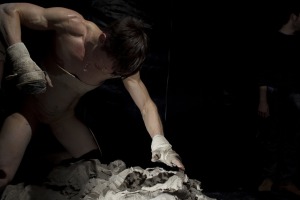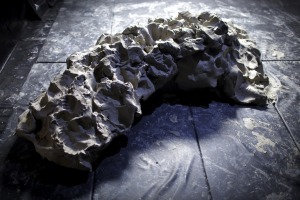We first came into contact with the work of Heather Cassils at Concordia’s Leonard and Bina Ellen Art Gallery. Three photographs documenting her 2012 performance, Becoming an Image, are included in the exhibition Material Traces: Time and the Gesture in Contemporary Art, curated by Amelia Jones. The photographs were captivating: the contrast of sculptural white flesh against their ink-black backgrounds, and their striking combination of visual clarity and representational ambiguity, captured and sustained our attention. Raw and visceral images of an androgynous figure apparently enacting violence on an unknown adversary, the photographs capture the controlled convulsions of a body fueled by adrenaline and aggression.

Becoming an Image, photo documentation of performance, 2012 (photo: Heather Cassils and Eric Charles)
Sparingly clothed, with breasts bound and fists wrapped like an under-dressed boxer, the physical fitness of the body is foregrounded. Her skin shines under a layer of sweat, her veins pulse as if about to burst and her face conveys both stamina and fatigue. The dried and cracking traces of clay on both her body and its bindings are the only visual clues as to whom or what might be her opponent. The art historians in us drew parallels to Michelangelo’s Slave Figures – those partially carved characters that imply attempts to escape the stone from which they are formed, a Manichean struggle between spirit and matter – or the dramatic and macabre mannerisms of Caravaggio’s or Gentileschi’s Renaissance paintings. Cassils’ title, Becoming an Image, only offered fuel to this associative fire.

Becoming an Image, photo documentation of performance, 2012 (photo: Heather Cassils and Erix Charles)
A couple of weeks after our encounter with the images, Cassils came to Montreal to perform Becoming and Image in the 20th annual Edgy Women Festival. In a sealed off and blacked-out section of the Club de boxe Chat blue on the evening of March 9th, we had the opportunity to witness the becoming of the images that we had been unable to get off of our minds. Before entering the performance space, we were inundated with a series of warnings: Don’t enter if you are prone to epilepsy or claustrophobia; Absolutely no cameras, phones, or anything else that emits light; stand against the wall and do not step forward or you risk getting punched; THIS PERFORMANCE CONTAINS VIOLENCE.
Excited and intrigued we quietly and carefully single-filed into the blackened room and braced ourselves against the wall as instructed. The first blinding flash of light permitted a glimpse – fleeting, but effective – of a 1500-pound block of clay standing in the centre of the room. We waited for what was next. Powerful exhalations of breath and the sharp smack of fists hitting clay signaled the artist’s entrance and the beginning of the battle.
For the 24-minute duration of the performance we remained in absolute darkness, save for the sudden and intermittent flashes of a large-format camera – that same camera used to produce the photographs we had seen in Material Traces. Subsequent strobes revealed the artist engaged in attack – punching, kicking, ramming against, and lunging upon the obdurate mass in an unremitting onslaught. With each flash came a false sense of self-stabilization. In their brief duration, we negotiated both the disorienting blindness they unleashed and the regaining of our bearings before being plunged again into darkness. We found ourselves bracing at the taking of each picture: reaching back to confirm that the wall, itself unstable, was still there; weaving and wavering in our stance; and startling at the grasping hands of strangers undergoing similar unsettlement.
Each of the camera’s shots left an afterimage imprinted on the eye so that the live performance was effectively experienced, not as continuous motion or the flow of time, but as a series of intangible images that mimicked the 19th century sequential photographs of Étienne-Jules Marey and Edweard Muybridge. Each of the artist’s poses was rendered perceptually repetitive as our minds and eyes desperately tried to elicit images out of obscurity and, with every click of the camera, the artist’s body had changed place, again restructuring the scene. The performance presented photographs as living images, or – perhaps, more accurately – the inverse.
In constant accompaniment to the visual intermittency was a sonorous score of grunts and groans, curses and heavy breath. We could hear her fists pounding against the clay and her feet darting about in the darkness. The realization that both performer and photographer were plagued by the same privation of light to which we spectators were subject was almost terrifying. They were forced to dance around and deflect one another as Cassils blindly battled her invisible opponent.
As time wore on, the images revealed victim and victor rather than opponents of like size and stature. We watched – if one can call it that – the clay topple and crash to the ground only to be mounted and further assailed by the increasingly exhausted artist. Eventually the performance ended. The lights came on and the artist and photographer were gone. What was left of the beaten body of clay lay exposed on the gym floor, mangled and molded into a sculptural sign of the assault it had undergone.

Becoming an Image, photo documentation of performance, 2012 (photo: Heather Cassils and Eric Charles)
What exactly became an image in this process of performance? Any number of answers would be appropriate. We were witness to the production of the “material traces” included in Jones’ exhibition. We watched an event become an image, but having seen the photographs first, also observed the image become event. Like a savage sculptor, beating the block of clay into submission, we watched as Cassils manufactured a form far removed from the idealized effigies of art history. This was an outright annihilation of those ideals. The agony and the ecstasy of artistic process exposed as violent tumult.
A body builder and physical trainer, Cassils has, in previous performances, chronicled the transformation of her own body into an idealized and hyper-masculine form. Directly confronting historical and contemporary notions of beauty and perfection, Cassils’ 2011 multi-platform piece Cuts: A Traditional Sculpture, for example, enacted an alternative updating of Eleanor Antin’s 1972 Carving: A Traditional Sculpture, in which the artist had photographically documented her own emaciation by self-imposed starvation over a period of three months. Cassils, in contrast, built her body up over the same stretch of time through extensive weight training, high caloric consumption (the recommended intake for a 190-pound male athlete) and the taking of steroids. Whereas Cuts attempted the absurd and impossible attainment of an ideal, Becoming an Image confronts, combats and suggestively overcomes that ideal. Art under attack, identity in crisis. As every adolescent is all too aware, becoming an image is never easy.
Becoming an Image was one of the most fulfilling pieces of performance art that either of us had ever experienced. If the opportunity ever arises, we urge you to attend one of Cassils’ performances and, in the meantime, to go see the photographs at the Leonard and Bina Ellen Art Gallery in Montreal. The images will be up until April 13, 2013.
Reilley Bishop-Stall and Natalie Zayne Bussey
© Passenger Art, 2013


Intense, great piece! I hope I get a chance to catch this performance some time soon. I wonder if there is also a roid-rage factor to the piece (since the artist has experimented with steroids).
Can you turn roid-rage on and off like that, the way a performance would demand? As one who has managed to avoid steroids in life I’m not sure. I think that kind of aggression, though beautifully and mercifully channeled into beating clay, comes with the whole process of becoming a bodybuilder. It’s a painful and very tough process, I imagine–one would probably not be inclined to take up needlepoint or cupcake baking after one of those workouts.
It sounds like a pretty visceral and consuming performance. So interesting.
Also, I’m really enjoying this new endeavour and I delight in reading these thought-provoking discussions (monologues?). It’s exciting to hear about these exhibits/performances/works and to hear your take on them, so thanks for putting this out there! I look forward to reading on….
Thanks for your comment Jaime, we hope you’ll stay in contact with us!
Natalie
Pingback: All That Remains: Tracing Time and Performing Process in Contemporary Art | passenger Art